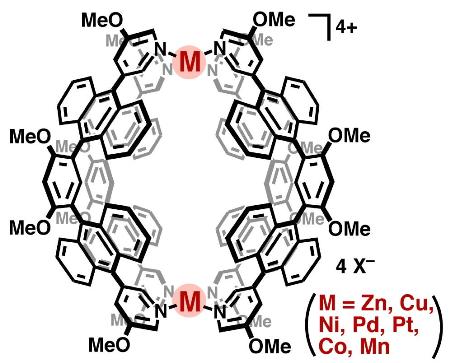Researchers at Tokyo Institute of Technology have synthesized blue-fluorescent molecular nanocapsules through simple mixing of bent organic blocks and eco-friendly green metal ions.
 Chemical structure of molecular nanocapsules
Chemical structure of molecular nanocapsules
The fluorescent molecular nanocapsules find use in drug delivery systems, displays and sensors, biological probes and LEDs. The researchers used green and low-cost copper and zinc ions to develop approximately 1-nm molecular capsules having an isolated cavity. These molecular capsules emit blue fluorescence with an efficiency of 80%. The researchers believe that multicolor fluorescence composites can be synthesized by simply filling the nanocapsule’s isolated cavity with suitable fluorescent molecules.
Coordinative self-assembly is the process used for the preparation of molecular capsules and cages. Nonetheless, majority of the cages and capsules are made up of precious metal ions like platinum and palladium and have poor fluorescence because of quenching by the heavy metals. The Tokyo Institute of Technology researchers have now developed innovative molecular nanocapsules made of the M2L4 composition, in which M represents manganese, cobalt, nickel, palladium, platinum, copper and zinc. Their copper and zinc capsules, especially demonstrate distinctive fluorescent properties.
The M2L4 capsules are formed through the self-assembling of two metal ions and four bent ligands, which include fluorescent parts such as anthracene fluorophores. X-ray crystallographic analysis confirmed the closed shell structures in which the capsules’ large interior cavities are protected by eight anthracene panels. Among the capsules, the zinc capsules demonstrated powerful blue fluorescence emission with 80% quantum yield, while manganese and nickel capsules were weakly emissive and cobalt, platinum and palladium capsules were non-emissive. However, the copper capsule’s fluorescence relies on the solvent; for instance, it emits blue fluorescence in dimethyl sulfoxide but does not emit in acetonitrile.
Source: http://www.titech.ac.jp